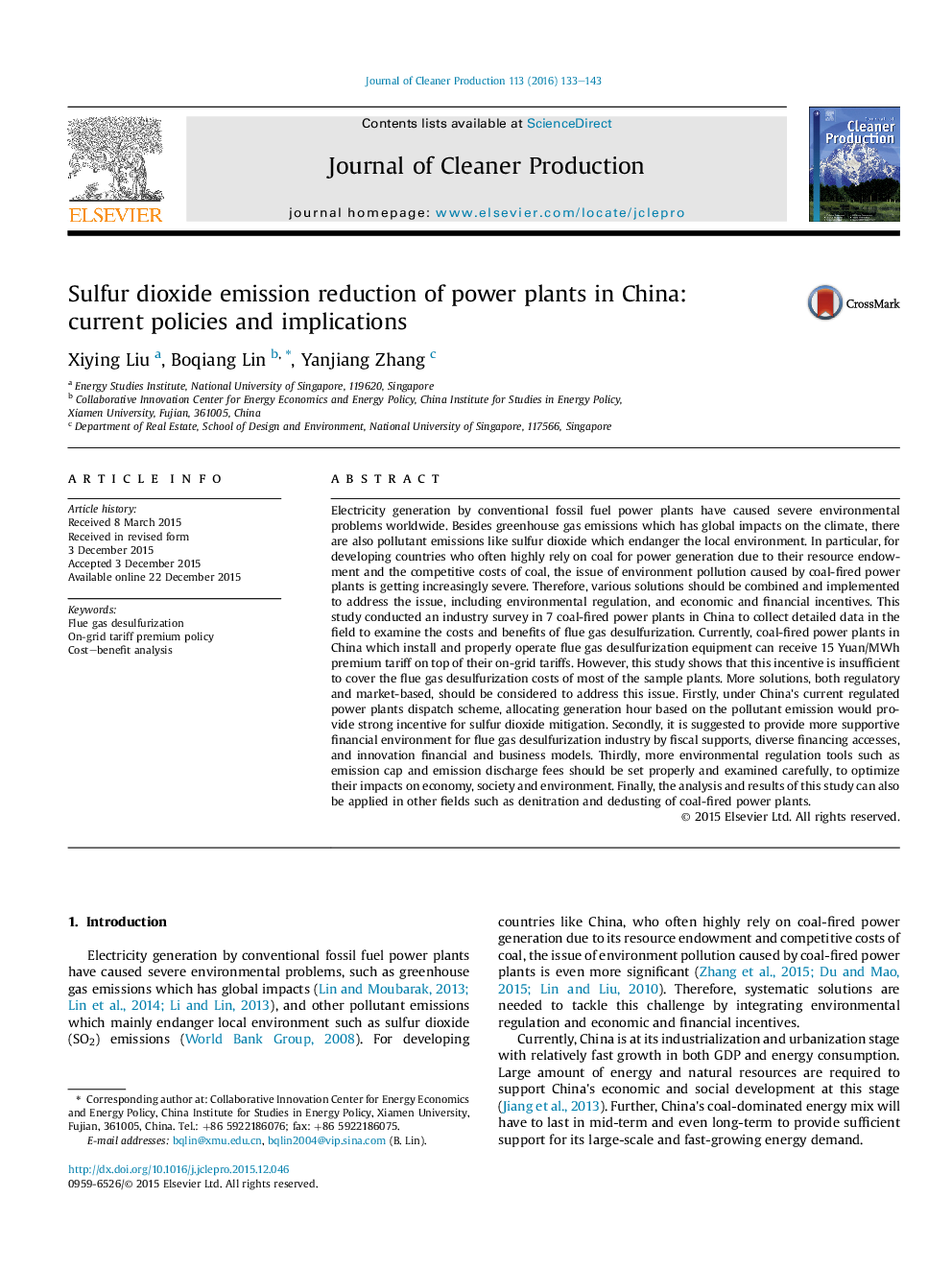| کد مقاله | کد نشریه | سال انتشار | مقاله انگلیسی | نسخه تمام متن |
|---|---|---|---|---|
| 8102826 | 1522136 | 2016 | 11 صفحه PDF | دانلود رایگان |
عنوان انگلیسی مقاله ISI
Sulfur dioxide emission reduction of power plants in China: current policies and implications
ترجمه فارسی عنوان
کاهش انتشار دی اکسید گوگرد در نیروگاه ها در چین: سیاست های فعلی و پیامدهای آن
دانلود مقاله + سفارش ترجمه
دانلود مقاله ISI انگلیسی
رایگان برای ایرانیان
کلمات کلیدی
سولفوریزاسیون گاز دودکش، سیاست حق بیمه تعرفه در شبکه، هزینه تجزیه و تحلیل سود،
ترجمه چکیده
تولید برق توسط نیروگاه های سوخت فسیلی متعارف باعث ایجاد مشکلات زیست محیطی شدید در سراسر جهان شده است. علاوه بر انتشار گازهای گلخانه ای که تاثیرات جهانی بر آب و هوا دارد، انتشار گازهای آلوده مانند دی اکسید گوگرد نیز وجود دارد که محیط زیست محلی را تهدید می کند. به ویژه، برای کشورهای در حال توسعه که اغلب به زغال سنگ برای تولید برق به دلیل منابع مالی خود و هزینه های رقابتی زغال سنگ اغلب به زغال سنگ وابسته اند، مسئله آلودگی محیط زیست ناشی از نیروگاه های زغال سنگ افزایش می یابد. بنابراین، راه حل های مختلف باید برای حل مسئله، از جمله مقررات زیست محیطی و انگیزه های اقتصادی و مالی، ترکیب و اجرا شود. این مطالعه یک بررسی صنعتی در 7 نیروگاه زغال سنگ در چین انجام داد تا اطلاعات دقیق در این زمینه را برای بررسی هزینه ها و مزایای سولفوریزاسیون گاز دودکش انجام دهد. در حال حاضر، برق نیروگاه های زغال سنگ در چین که تجهیزات سولفوریزاسیون گازسوز را نصب و به درستی کار می کنند می توانند تعرفه حق بیمه 15 یوان / مگاوات ساعت را در بالاتر از تعرفه های شبکه خود دریافت کنند. با این حال، این مطالعه نشان می دهد که این انگیزه برای پوشش هزینه های سولفوریزاسیون گاز سوخته در اکثر گیاهان نمونه کافی نیست. برای مقابله با این مسئله باید راه حل های بیشتر، هر دو مبتنی بر نظارت و بازار، مورد توجه قرار گیرند. در مرحله اول، تحت برنامه ارسال نیروی برق تحت کنترل چین، اختصاص دادن ساعت تولیدی بر اساس انتشار آلاینده باعث ایجاد انگیزه قوی برای کاهش میزان دی اکسید گوگرد می شود. ثانیا پیشنهاد می شود که محیط مالی مناسب برای صنعت سولفوریزاسیون گازوئیل با حمایت مالی، دسترسی های مالی متنوع و مدل های مالی و تجاری نوآورانه فراهم شود. سوم اینکه، ابزارهای تنظیم مقررات زیست محیطی مانند کلاهبرداری و هزینه های تخلیص انتشار باید به درستی تنظیم و مورد بررسی قرار گیرد تا بهینه سازی تاثیرات آنها بر اقتصاد، جامعه و محیط زیست. در نهایت، تجزیه و تحلیل و نتایج این مطالعه همچنین می تواند در زمینه های دیگر مانند انحلال و تخریب نیروگاه های زغال سنگ استفاده شود.
موضوعات مرتبط
مهندسی و علوم پایه
مهندسی انرژی
انرژی های تجدید پذیر، توسعه پایدار و محیط زیست
چکیده انگلیسی
Electricity generation by conventional fossil fuel power plants have caused severe environmental problems worldwide. Besides greenhouse gas emissions which has global impacts on the climate, there are also pollutant emissions like sulfur dioxide which endanger the local environment. In particular, for developing countries who often highly rely on coal for power generation due to their resource endowment and the competitive costs of coal, the issue of environment pollution caused by coal-fired power plants is getting increasingly severe. Therefore, various solutions should be combined and implemented to address the issue, including environmental regulation, and economic and financial incentives. This study conducted an industry survey in 7 coal-fired power plants in China to collect detailed data in the field to examine the costs and benefits of flue gas desulfurization. Currently, coal-fired power plants in China which install and properly operate flue gas desulfurization equipment can receive 15 Yuan/MWh premium tariff on top of their on-grid tariffs. However, this study shows that this incentive is insufficient to cover the flue gas desulfurization costs of most of the sample plants. More solutions, both regulatory and market-based, should be considered to address this issue. Firstly, under China's current regulated power plants dispatch scheme, allocating generation hour based on the pollutant emission would provide strong incentive for sulfur dioxide mitigation. Secondly, it is suggested to provide more supportive financial environment for flue gas desulfurization industry by fiscal supports, diverse financing accesses, and innovation financial and business models. Thirdly, more environmental regulation tools such as emission cap and emission discharge fees should be set properly and examined carefully, to optimize their impacts on economy, society and environment. Finally, the analysis and results of this study can also be applied in other fields such as denitration and dedusting of coal-fired power plants.
ناشر
Database: Elsevier - ScienceDirect (ساینس دایرکت)
Journal: Journal of Cleaner Production - Volume 113, 1 February 2016, Pages 133-143
Journal: Journal of Cleaner Production - Volume 113, 1 February 2016, Pages 133-143
نویسندگان
Xiying Liu, Boqiang Lin, Yanjiang Zhang,
